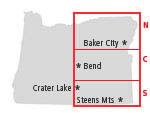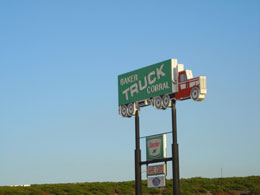







 |
 |
 |
 |
 |
 |
 |
 |
 
Baker City |
Weather Thou Goest Sometimes you just have to drive. When its autumn and the skies are still blue and the leaves are at their most striking, I have the urge to leave my own wooded wonderland at the foothills of Mt. Hood, and head for the wide-open spaces of Eastern Oregon. From Welches, I cut across the eastern flank of the mountain through the orchards of Parkdale, where I stop to buy apples and pears and wave goodbye to Mt. Hood looming nearly naked in my rearview mirror. At Hood River I join I-84 heading out of the wooded west and into that vast landscape following the Columbia River east. Autumn is different here. The colors are more subtle, but gorgeous in their own way. Every outcropping of vegetation seems like a marvelous watercolor. Ponds and riverside edges are full of new arrivals migrating south — a potpourri of ducks. Near the John Day Dam, herds of bighorn sheep graze unfazed by the highway. The Columbia River continues on its way and I go mine, separating at Boardman. I am still in the sun, still in autumn, heading toward Pendelton when the world changes. I always like Pendleton and its lovely valley surrounded by wheat-covered hills. No matter what time of year I find it pleasing, but today it is breathtaking. The sun strikes the golden hills and snow has dusted the upper reaches where black clouds roil above, hiding the hilltops. It is a marvel to behold, but it is a warning too. I’ve been caught in dense fog in this Cabbage Hill pass. The digital highway sign confirms what I suspect: Fog ahead. I take it slow, not in a hurry to get there, cautious to stay away from other vehicles. As I make the grade, however, the sign wasn’t entirely accurate. It is frozen fog. Up on top, my defroster has trouble keeping up with the fog as it freezes on my windshield. Worse, you can’t see it freezing on the highway. The fog makes it seem like night, but it is not dense enough to obscure the sight of semis and horse trailers, SUVs, pickups and sedans strewn every which way. They are reversed on the edge of the highway and have been tossed into ditches and onto snow banks. Tow trucks are everywhere too. I see no ambulances and no one seems injured. Their vehicles simply are no longer engaged with the pavement. As we descend from the plateau, I see brake lights flash as the traffic seems to cluster ahead of me. A semi loses ground and slides. The tanker in front of me slows. I slow too, but downhill momentum increases my speed. I barely touch my brakes and I am spinning. I am three car-lengths from the tanker and no one is beside me. Miraculously, no one is behind me either. I work as fast as I can, clockwise, counter-clockwise, correcting the steering wheel as I turn into the direction my wheels take me. When you’re spinning out of control every thing looms large. The concrete meridian seems massive. The tanker in from of me…well I can’t think about the tanker. Somehow I have plenty of room for my own private icecapades. Yet it is not “Whee! What fun!” It is “Please get me out of this!” Suddenly, I cross a dry patch of pavement and a bit of gravel and know I have only an instant to tap my brakes. Just like magic, my car is under control and headed in the right direction. The tanker is less than a car length now, but my car has not careened into it and burst into flames. I wonder if the driver got to watch me. I maneuver over to the side of the road, half off the pavement, where the gravel has collected and get my tires firmly in it. Now I have time to be jittery and realize my heart is pounding. I feel the weakness in my stomach and my arms. I can’t relax. I still have 30 miles to go before La Grande and the fog is still freezing on the windshield and the road. I stick behind the tanker. There is no traffic behind us and I wonder if they’ve closed the road. We are going 20 miles per hour. It will be a long thirty miles. The next day, I do not continue east to take in any sights and breathe in those wide-open spaces. I want nothing more than to be safe at home. It was a freak freeze and the temperatures hover at 10 degrees. I wait until noon to take advantage of the sun melting ice and scoot back through the canyons and plateaus and the treacherous Cabbage Hill without incident. Dry pavement and sunshine all the way. I am still jittery though and decide not to take the short-cut home across the mountain via Hood River. I cannot get out of my head a vision of sliding down the south face of the mountain from Government Camp to Welches. It’s the Troutdale exit for me off the freeway and then backtracking the lower elevations on Hwy 26. I am finally home and safe and I want to stay home. I have no desire to drive. I have no desire to see wide-open spaces and new horizons. I am perfectly happy to stick close and walk to the store. The rains come and I’m glad for it. Glad for the yard and the woods and glad for the salmon that have been anxiously waiting. A couple weeks of being home in the rain though, and there’s the urge to drive again. But it’s nearer winter now and I will not go east. I will go west. I will drift through the Willamette Valley to some small town for lunch. I will find myself in the Coast Range and eventually seek the ocean. That’s the plan. I will drive with no exact destination, only somewhere not likely to have ice and snow. As I leave my home, I wave goodbye to Mt. Hood covered in new snow. See ya’ later, gotta drive. back
to Northeastern Oregon overview
|